
RICHTV.NET ![]()
![]() got Protection Oregon U.S.A.
got Protection Oregon U.S.A.
Free to Air -- free tv like it used to be
KU Band only - single/twin linear LNBf
Made for the USA, Mexico, Canada, and the rest
.1/.2 db noise fig.; high stability; measured s/n using meters from Ku Band U.S. Satellites
To make almost no noise itself today this determines stability in statics; focus az/el as mount and satellite dish provides powered reflection of up to 50 and more satellite directions; the LNBf is the heart pumping over 200 channels per satellite
Universal means 1 gig each 500Mbx2 and 4 X bandwidth in KU band signal's available with built-in 22 khz. SW and standard 18/14vdc polarity; 10.2-12.7 GHz. linear or circular (US or Inter.)

twin LNBf
NEW Avenger Twin .1 db universal with multi-switch
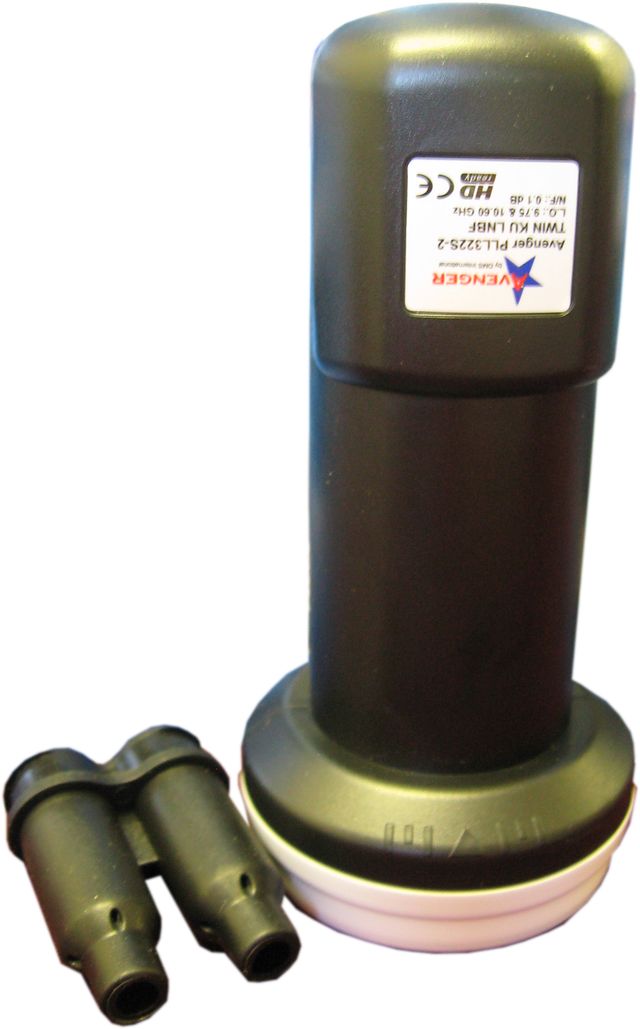 $28.00
$28.00
4 ku band's 10.2-11.2-11.7 and 11.7-12.2 and 12.2-12.7
low noise blockconverted with voltage switched (18/14 vdc) standard polarity Two LNBf one satellite - two probes depend on 18 vdc/14 vdc "standard" switch voltage to apply the band from each polarity sw by one of the two voltages 18/14 vdc select. from either "lnbf";
a 2x4 switch locks the lnbf to both polarities at the same time, a best practice today.
LNB
LNB - low noise blockconverted (18vdc only) and required (2) LNB (18vdc only), one for each polarity (H/V) or motored 3-wire serviced servo (5vdc/pulse/gnd) polarity for one lnb to change to either polarity in one receiver designs. The term LNBf is 2 lnb's with a built-in 18/14vdc H/V switch, all inside the lnbf.
TWO LNB - two probes; and dual lnb feed; and dual lnb switch (like stacking, the selection by the switch is of the tuned polarities received by a satellite dish aimed; and provides 500 Mhz. X 2 = 1 gig; multi-receiver technology was born. These had 18 vdc to power the switch; and both 950-1450 Mhz. LNB were bandwidth selected by using 18 or 14 vdc switching at each receiver output to the switch which then changed polarity; allowing the cable company to have 24 channels from up to 50 satellites; the entire satellite to be used for the new multi-channels (200 and more) they each can have available.
Old typed satellite dish was a cavity that is motored using a servo to move "the probe" to either polarity for one LNB type design's; then costing from 1000 to 100 to 50 each LNB; servo's had no standard until the end of servo and Chaparral which are still used today (and in many other products like drones and camera's); and dual lnb design's with a sw were used for the "polarity" worked continuously through the switch for all 24 channels each satellite had which are Vertical and horizontal bands 12 channels each at the same time (todays digital theory uses many bands for many channels from each "pld channel and bandwidth"; by the switch to power 18 and 14 vdc (now 200 per); called a lnbf; sized cavity is the only difference in setting up your satellite dish for each satellite
Mounting the LNBf to the dish.
LNBf's are placed onto your dish must be placed perfectly and aligned (v/h or circ.az/el only) for them to work on the satellite dish system you choose; each work in tandem with the satellite dish and LNBf as the aimed part of the "system" which is a dish design aimed; what the LNBf receives is the bandwidth it can aim at without shadows and gain in a direction is accrued from the middle of the dish.
Selection of the lnbf is a very important factor when it comes to your installation. If you want a certain type of pay receiver to work with your lnbf; if you want the lnbf to tune the channel you want to receive; if you want a certain frequency; you must choose the correct one. To receive circ. KU band (DBS) a knock or a circ. plastic plate is used by directv or dish network to make only circularly polarized signals/bands availablr. For C Band; only a thicker plastic insert (block) works because a knock would attenuate the weaker c band form too much; as C Band requires more "open space".The design is all considered 80's typed as the real antenna is (2) small wires in the round/sq. waveguides; using a 18/14 vdc switch; they select one of the two "bands" which left/right or hotizontal/vertical "formula's" of bands at freq./pol./symbol rate/ and f.e.c.; or programs of bands (each a slice of a pie/dome/mound of freq.); block converter is the same as the tuner does all the work for the dish/lnbf combo is an amp of each type of satellite and it's own providing of its direction to the "space it is in"...
LNBf are either circular L/R or linearly H/V polarized; and must have the correct band of frequencies available in your Country. Each lnbf also relies upon where the dish is aimed and locked to and if it moves even a quarter inch. The two (2) Band's of frequencies in the USA for Free to Air channel's "tuning" using a digital satellite receiver; is C BAND 3.7-4.2 GHz and KU BAND 11.7-12.2 frequencies (both are 500 MHz. in width as a band of frequencies). As long as the LNBf tunes linear signals; the LNBf must be skewed for a single satellites reception (alignment of the real antenna, called a probe inside the cavity of an lnbf).
The mount's and mark's
Each AZ/EL dish has the first offset, or "0"; that the lnbf is mounted in relation to the dish aimed and printing of these two numbers are on.the two mounts; the lnbf mount has skew; the dish mount has elevation mark for the placed lnbf; and the pole/dish clamp has the Azimuth or directionally gained satellite the entire assembly must be pointing at (using compass direction it is aimed from behind the dish and from a true south reading of the compass). Then 180 (true south) is the number used and using the online calcualator's number is subtracted from if less than 180; or added to if the satellite location number is to the west or more than 180 (true south). I.E. - 180 +/- the satellite's direction; 180-150=30 degree's from true south to the east.
The online calculators, whether hosted by the broadcaster or free software run types, each have many different Types of satellites in space; their channel line-up and the received data the free to air channel's provide as broadcast channel's; then the receiver can use (tune in) the many free to air signal's to show the channel's.
Center of dish AZ/EL mount determining one direction and one skew of lnbf (linear) manally which can be center focused or offset design of satellite dish aimed; is the dish/lnbf assembly mounting and markings instructions for each dish brand
DISEq 1.2/3 motor and mount - Skews automatically; with single offset or center of dish mounting depending on dish design. The markings on the mount and assembly allow you to realize the final focus by following included directions/assembly for movement across Clarkes arc and an over 50 gig site survey. The motor is controlled, and programmed by the user for those free to air signal's found throughout North and South America.
Here, even 1 degree means whether the satellite is received; and any shadows show in metering (usually braces/lnbf/mount) but depends on dish/assembled parts included design of which they use offset for elevation of the center lnbf.
Mounting your lnbf to your dish is required to be perfect; no matter which one you mount it onto.
mounting more than one depends on where the first one [main at offsret or not] is pointing and the shape of the dish and then where it points or skew if any. Here is the real directionals; when using the middle of the dish for max. gain; the lnbf's offset is their AZ/EL aiming for each lnbf that is placed to the dish; the trick is to not shadow any direction of any placed lnbf.
DBS dishes skew "differently" only in their own direction's by manually turning (skewing) their lnbf and multi-sat assembly. and they aim up to 5 lnbf's at Clarkes arc space and receive circular signals at dbs frequencies (12.2-12.7 or Hybrid plans); but they have signal shadows in their own dish aiming design also; the thickness of the designers heads.
An 18" dish can actually receive ALL 15 DBS satellites with 15 LNBf's; they just never knew it could be accomplished with their oldest design (they never tryed).
Multi-sat LNBf bracket; steel is the bracing used; to use it without shadowing each other; the dish and design is turned upsidedown for 42 satellite system has 42 lnbf's and 21 bracket's...
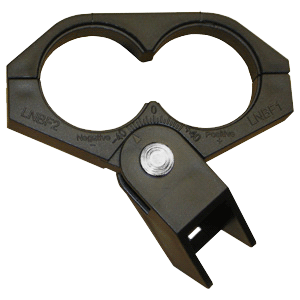












 these are for 4 degree spaced satellites; to get all satellites at 2 degree's, 2 satellite dishes are used; or a 14-18 vdc motor;
these are for 4 degree spaced satellites; to get all satellites at 2 degree's, 2 satellite dishes are used; or a 14-18 vdc motor;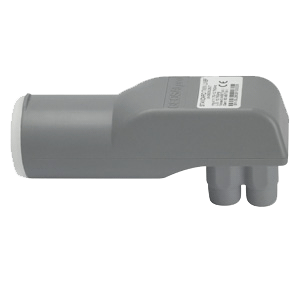







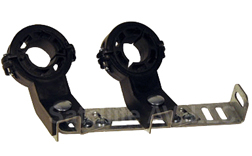 2 more lnbf holders with bolt-on steel bracing easy as 1/2/3. Making the dish and plate aimed assembly static; braced and un-able to move; makes the installed parts using only a switch (DISEq 1.0 or 1.1) able to tune more channels. Used by the cable company in the past; makes your dish work better by adding entire whole satellites with other channel's (up to 10,000 channel capable); just like dbs satellites do!
2 more lnbf holders with bolt-on steel bracing easy as 1/2/3. Making the dish and plate aimed assembly static; braced and un-able to move; makes the installed parts using only a switch (DISEq 1.0 or 1.1) able to tune more channels. Used by the cable company in the past; makes your dish work better by adding entire whole satellites with other channel's (up to 10,000 channel capable); just like dbs satellites do!





 Using a glorystar 90 cm. dish (42 KU Band lnbf's and diseq SW with 32x2 positions is one 42) and (21) brackets allows reception of 42 more satellites! And another (21) would (this is not impossible except there are really about 50 total satellites) allow another 42 more satellites (it is not easy). LNBf's extra (eye's to the world of satellite tv). With this type of hook-up; almost any channel available you may want can be received. They do not write instruction's for these require perfect center-of-dish aiming at offset without shadow or terrestrially based blockages tree's building's and elevationally use the entire dish.
Using a glorystar 90 cm. dish (42 KU Band lnbf's and diseq SW with 32x2 positions is one 42) and (21) brackets allows reception of 42 more satellites! And another (21) would (this is not impossible except there are really about 50 total satellites) allow another 42 more satellites (it is not easy). LNBf's extra (eye's to the world of satellite tv). With this type of hook-up; almost any channel available you may want can be received. They do not write instruction's for these require perfect center-of-dish aiming at offset without shadow or terrestrially based blockages tree's building's and elevationally use the entire dish.
C+Ku Band lnbf w/22 khz. SW-allows second dish; or diseq SW; or dual band single satellite (2Gig in width) or motor or 4DTV dsr922 reciever use; or Commercially for each satellite or only one channel each.

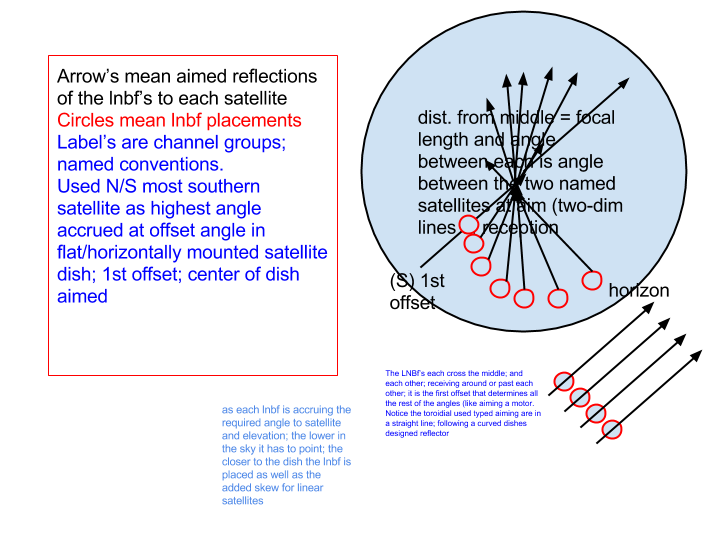
both bands below...C + KU means a very big ugly satellite dish is needed!
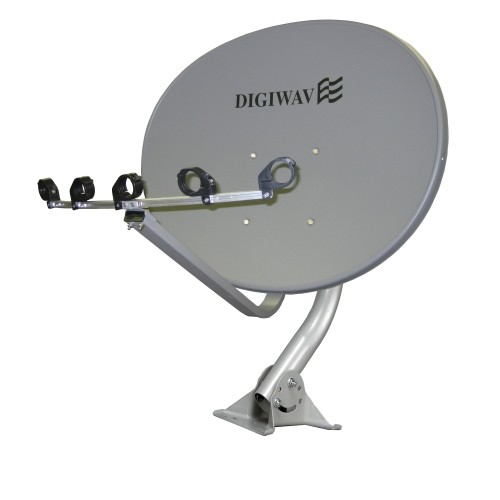

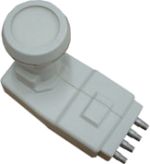
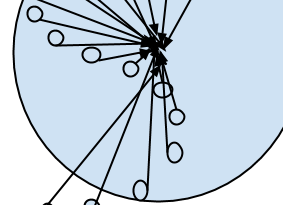

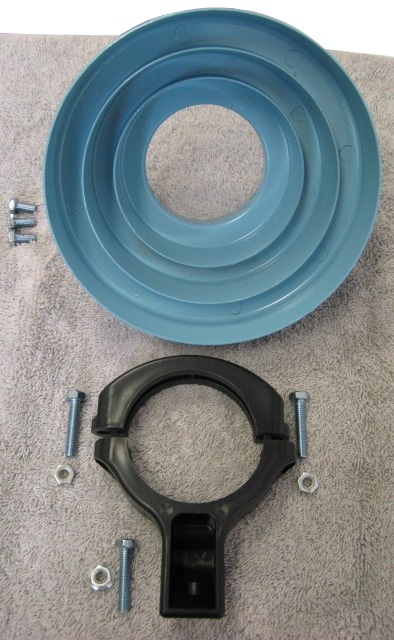
If you want it to work with a switch of a certain type, if you want a certain satellite in space; you will want the best outside cables to your box and labels for each with the named convention of channels and their data points; only the correct lnbf perfectly aimed and skewed will work. Using a switch isolates each point in free air receptive selection allows all systems a go. Any FTA receiver hooked to a switch system needs a switch called a 1.0 or 1.1 DISEqC protocol handled in the scanned satellite/channel list the owners of each switch program their receiver with; and then hookup and watch the fta list for each receiver.
and technosaavey has a new verse:
New dishes with lnbf holders in place are made to only one size, needing the extra parts commercial styled dishes use as the many sized LNBf today fits almost any lnbf made with included mount parts. Multi-satellite mounts are per sized as they must fit to original designed center focused offset for elevation (designed single satellite focused); and then physically apply the mount for each 4+ degree satellite otherwise, the scalar rings need cutting type lnbf)